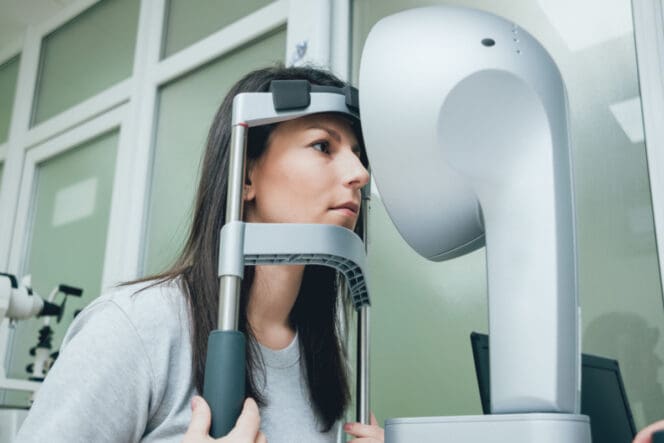Home / Eye Health /
Visual Field Testing: What You Need to Know
Your field of vision is the extent of space in which the eye can still capture objects while looking in one direction. Visual field tests do not quantify the quality of your vision. Instead, they put numbers to the range of vision.
What Is Visual Field Testing?
Visual field testing is an eye exam that determines the scope of your vision when you focus your eyes on a central object. The exam tries to determine if you have blind spots and their location.
Why You Need a Visual Field Test
You need a visual field test to detect any threats to your vision. Visual field tests:
- Screen for glaucoma
- Test for toxicity that results from certain medications
- Evaluate and determine the extent of retinal diseases, including pigmentosa and retinitis
- Detect eyelid conditions, including drooping (ptosis)
- Check for any problems around the optic nerve such as optic neuritis, optic neuropathy, stroke, injury or tumors
- Detect any critical nutrient deficiencies

Types of Visual Field Tests
These are the six key visual field tests:
- Confrontation visual field test
- Electroretinography
- Automated static perimetry test
- Kinetic visual field test
- Frequency doubling perimetry
- Amsler grid
Confrontation Visual Field Test
In this test, you cover one eye and use the open eye to look at an object in front of you. During this exercise, the doctor may display other items or objects in your side or peripheral vision field and ask how many you can see.
Electroretinography
During the electroretinography (ERG) test, the doctor dilates your pupils and holds the eyes open using a speculum before applying some numbing eye drops. He then places an electrode on your cornea.
Finally, they will ask you to focus your eyes on a bowl-shaped machine while subjecting them to light flashing light patterns. The electrode determines your eye’s electrical activity as it responds to the light.
Automated Static Perimetry Test
The test’s goal is to test for a specific suspected eye issue. It involves looking at the center of a bowl-shaped testing machine called a perimeter, with the eye not being tested covered with a patch.
The testing eye will look through a prescription lens to ensure you can see well. Your doctor will encourage you to look at the center target all along.
As dim lights begin to blink throughout the bowl, you will need to press a button as soon as you see the light. The machine isolates which lights you cannot see.
Kinetic Visual Field Test
The Kinetic visual field test is similar to the perimetry test. As the word “kinetic” suggests, the only difference is that it uses moving light targets, not blinking lights.
Frequency Doubling Perimetry
Frequency doubling perimetry leverages optical illusion to assess the extent of damage to your vision. It involves black and white vertical bars flickering at different rates on the perimeter screen.
If you cannot see these bars at certain times while testing, it could mean lost vision in certain areas of your vision field.
Amsler Grid
You are presented with a network of equal squares and asked to look at one dot in the center of the grid.
You must identify and describe any blank, blurry, and wavy areas. Although the Amsler grid test specifically measures the visual field’s middle, it is instrumental for tracking vision changes.
Who Needs It?
Visual field testing is critical for individuals at risk of losing vision from disease, age or other complications. If you fall under any group of people listed below, you should see an ophthalmologist regularly for visual field testing:
- Multiple sclerosis
- Central nervous system issues
- Glaucoma
- Stroke
- Pituitary gland disorder
- Prolonged use of certain medications that impact negatively on vision
- Diabetes and blood pressure patients
Visual Field vs. Visual Acuity
Visual acuity refers to your eye’s ability to determine details on a near or distant object. In short, it relates to your ability to make details through near or distant vision.
On the other hand, the visual field denotes the extent or sense of space. It is the central and peripheral visual capabilities of your vision. A visual field test will determine how well you can see from the corners of your eyes or if you have blind spots.
References
-
Chapter 116: Visual Fields. (1990). Clinical Methods: The History, Physical, and Laboratory Examinations, 3rd Edition.
-
Visual Field Test. (March 2022). American Academy of Ophthalmology.
-
Visual Acuity, Visual Field, and Factors Influencing Automobile Driving Status in One-Thousand Subjects Aged 18 to 59 Years. (October 2017). International Journal of Ophthalmology and Clinical Research.
-
Visual field testing. (September 2020). Cleveland Clinic.
Last Updated July 1, 2022
Note: This page should not serve as a substitute for professional medical advice from a doctor or specialist. Please review our about page for more information.